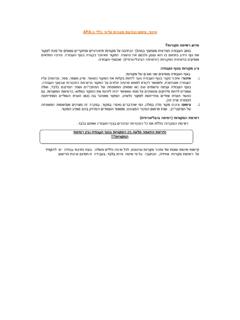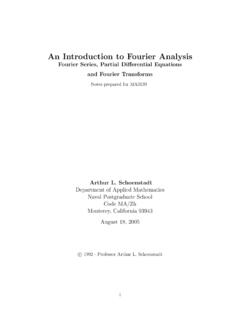Transcription of Microsoft Word Equation Editor Tutorial - BGU
1 Microsoft Word Equation Editor 1 Tip A) Use Alt-= to start an Equation . 1. Letters. Use a keyboard for regular Latin letters. For drawn one, you can use \doubleN to create , \frakturN to create , \scriptN to create . Use \double for , \fraktur for , \script 4 . Enclose in quotes regular text. a = b produces instead of.
2 For the Greek alphabet, spell the name of the letter, preceded by the backslash. If the name begins with a high case letter, a high case Greek letter is inserted. The Equation Editor s collection of Hebrew characters is limited to the first four. Keywords are case-sensitive ( , \rightarrow is different from \Rightarrow). For Type For Type For Type For Type For Type For Type For Type \dd \ii \jmath \zeta \Zeta \varpi \Dd \Im \partial \eta \Eta \rho \Rho \ee \imath \Re \theta \Theta \varrho \ell \j \wp \vartheta \sigma \Sigma \hbar \jj \iota \Iota \varsigma For Type For Type For Type \kappa \Kappa \tau \Tau \aleph \alpha \Alpha \lambda \Lambda \upsilon \Upsilon \bet \beta \Beta \mu \Mu \phi \Phi \beth \gamma \Gamma, \G \nu \Nu \varphi \gimel \delta \Delta \xi \Xi \chi \Chi \dalet \epsilon \Epsilon \o \O \psi \Psi \daleth \varepsilon \pi \Pi \omega \Omega 2.
3 Symbols. Type Type Type Type Type Type Type Type Type !! \asymp \cup \equiv \ni, \contain \rmoust \succeq ->, \to, \rightarrow \Rightarrow .. \because \dashv \exists \odot \setminus \superset \gets, \leftarrow \Leftarrow :: \bot \ddots \forall \ominus \sim \superseteq \uparrow \Uparrow := \bowtie \defeq \frown \oplus \simeq \therefore \downarrow \Downarrow ~= \boxdot \degc \heartsuit \otimes \smile \times \leftrightarrow \Leftrightarrow +- \boxminus \degf \in \overbracket \spadesuit \top \updownarrow \Updownarrow -+ \boxplus \degree \inc \parallel \sqcap \underbracket \nwarrow \Longrightarrow <=, \le \bullet \Deltaeq \infty \perp \sqcup \underline \nearrow \Longleftarrow >=.
4 \ge \cap \diamond \ldots \prec \sqsubseteq \uplus \swarrow \Longleftrightarrow << \cdot \diamondsuit \left \preceq \sqsuperseteq \vdash \searrow \hookrightarrow >> \cdots \div \lmoust \propto \star \vdots \rightharpoonup \hookleftarrow \angle \circ \doteq \models \ratio \subset \vee \rightharpoondown \break \approx \clubsuit \dots \nabla \rddots \subseteq \wedge \leftharpoonup \lrhar \ast \cong \emptyset \neg \right \succ \wr \leftharpoondown \mapsto Bug: The \clubsuit symbol can be problematic. 3. Accent. For Type For Type For Type For Type For Type For Type x\bar x\acute x\breve x\check x\dot x\prime x\Bar x\grave x\hat x\tilde x\ddot x\pprime x\ubar x\vec x\tvec x\lvec x\dddot x\ppprime x\Ubar x\hvec x\rhvec x\lhvec x\ddddot x\pppprime 4.
5 Spaces. Because spaces have special meaning in the Equation Editor , and because the Equation Editor usually handles spacing appropriately, the spacebar cannot usually be used to add spaces within equations. However, spaces can be inserted using keywords. The \zwsp means "zero width space". The \itimes used for math multiplication. The \medsp is "medium mathematical space". The \zwnj means "zero width non-joiner". For Type \emsp \ensp \vthicksp \nbsp \thicksp \thinsp \hairsp \zwsp \itimes \medsp \zwnj Add blank space before colon to make it binary operator: vs . 2 Microsoft Word Equation Editor Tip B) If the keyword does not apply, add an extra space.
6 5. Superscripts, Subscripts, and Formatting. The ^ and _ keys are used to insert superscripts and subscripts. Grouping is important because it distinguishes between and . Terms can be grouped by enclosing them in parentheses, where the parentheses themselves do not print. 6. Brackets. The brackets are grouped to easier work. Be sure to make space following each closed bracket. The \begin and \end brackets are used for "invisi-ble" grouping, as in last parameter in the nary operators (sum, product, etc.). Sometimes you need unbalanced brackets, use \open and \close to balance them. The last column vertical bars can be used as middle separators inside the brackets and balanced with them. Use /middle before some symbol if you want to make it separator. For For Type ( |, \vert \norm, \Vert \bra, \langle \bra, \langle \lbbrack \lceil \lfloor \begin \open Type \mid For For Type ) ] } |, \vert \norm, \Vert \ket, \rangle \Rangle \Rbrack \rceil \rfloor \end \close Type \vbar The Equation Editor causes brackets (such as [], {} and ( )) to grow to the size of the expression within them.
7 However, parentheses are the group-ing character and will not display when used as such. To force parentheses to display, you must double them. To prevent brackets from being reformatted, precede them by the \ character. Bug: Never try to select with a mouse the brackets. For Type Comments [ ] { } ( ) [a/b] or {a/b} or (a/b) Parentheses display. a/(b+1) Parentheses used for grouping do not display. { {a\atop b y\close | | |(a|b|f)/(c+d)| The parentheses are, again, used for grouping. | | |a|b|f/(c+d)| y=\[ a/b \] Backslashes prevent [ and ] from growing. |[\zwsp\close\close {x\in\doubleN\mid x<100} {x\in\doubleN\middle*x<100} The * will be the separator. "He said: "\zwnj\pprime "Hello"\zwnj\pprime.]}}
8 Make quotes visible. The keywords phantom and smash can be used to force brackets or parentheses to have a specific size. The symbols below are invisible. For Type \asmash \dsmash \hsmash \smash \hphantom \phantom \vphantom For example: For Type Comments [] [\phantom (a\atop b)]<sp> The \phantom command creates an object as large as the expression in parenthe-ses, but does not print it, so you can create, for example, large empty brackets. [\hphantom((a+b)/c)] The \hphantom command creates an object with the width of the expression in parentheses, but zero height. [] [\vphantom((a+b)/c)] The \vphantom command creates an object with the height of the expression in parentheses, but zero width. [\smash(\sum_(l=0)^5\of\begin l*2\end)\close The \smash creates the object, but makes its size zero so that the enclosing bracket does not grow.]
9 Bug: Looks different on printing. Used and fixed in this paper: ~mathiho/useful/ Equation %20 Editor %20 Shortcut% For Type For Type For Type Comments x_i\times y^n \rect(y=x+4) \box(y=x+4) Invisible box for formatting purposes. x^(i+1) \underbrace F_ force" \overbrace F^ force F_n^(k+1) \underparen(a+b) \overparen(a+b) F_(n^(k+1)) \underbar(a+b) \overbar(a+b) Also possible \overline(a+b). (_0^9)H \overshell(a+b) Microsoft Word Equation Editor 3 Tip C) Use professional vs linear mode to fix typos. 7. Division and Matrices. For Type Comments a\/b a/b a\sdiv b (a+b)/(c+d) ((a+b))/(c+d) The double parentheses force the single paren-theses to print in the numerator.
10 ((a+b)/(c+d) + n)/(f(x)+e^(1\/2)) The / is preceded by \ in the exponential to provide a horizontal fraction (1/2 instead of ). a\atop b (a+b)\atop(c+d) \matrix(x_11&x_12&x_13@ x_21&x_22&x23@x_31&x_32&x_33) The matrix must be enclosed in () s. The & character separates columns of the matrix. The @ separates rows. ( ) \pmatrix(x_11&x_12&x_13@ x_21&x_22&x23@x_31&x_32&x_33) \Vmatrix(x_11&x_12&x_13@ x_21&x_22&x23@x_31&x_32&x_33) [ ] [\matrix(x_11&x_12&x_13@ x_21&x_22&x23@x_31&x_32&x_33)] \eqarray(x_11&x_12&x_13@ x_21&x_22&x23@x_31&x_32&x_33) { \cases(x:=5,x<3@x:=8,x>=3) ( ) \identitymatrix 8. Roots. 9. Negation. Some math symbols can be negated.}










